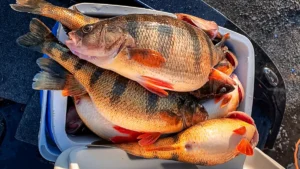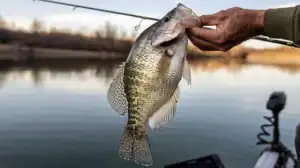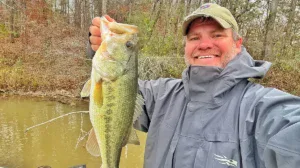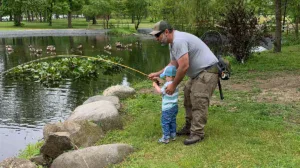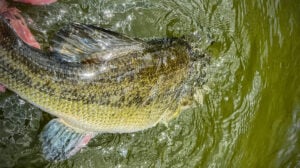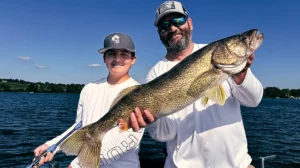During the spring season anglers all over the country flock to the bank in search of spawning fish. You can catch bass on all sorts of shallow cover this time of year, however the patterns vary based on what stage of the spawn they’re in. One type of cover then tends to hold fish throughout all stages of the spawn is sea walls. Fish use this cover for a variety of different reasons, and they tend to hold some quality fish. While targeting sea walls isn’t always easy, it can lead to some quality limits of bass. This feature covers how and when to fish sea walls throughout all stages of the spawn.
WHY DO BASS USE A SEA WALL
A sea wall is simply a retaining wall typically used around residential areas to stop erosion. These walls can be constructed out of various materials, and often have anywhere from a few inches to a few feet of water on them. Bass use this structure for a variety of reasons. Sea walls serve as the perfect location for bass to feed, stage and spawn throughout the spring.
These walls create the ideal location for bass to run and ambush prey. Furthermore, they provide protection from waves and often have hard bottom, creating an ideal location for both bass and bluegill to spawn. Depth, forage and geographic location are the three most important factors when putting together a sea wall pattern. These factors determine what sea walls these bass will hold on during each stage of the spawn.
TARGETING SEA WALLS IN THE PRE SPAWN
I love targeting sea walls throughout all stages of the spawn, and the prespawn is no exception. Covering lots of water is typically my go to strategy this time of year, as bass are often on the move in search of forage and spawning locations. I often start out on main lake sea walls, throwing a variety of different moving baits. Bass will use these locations to feed up on shad and other baitfish before making their way to their preferred spawning grounds. Reaction baits such as a Megabass Vision 110 Jerkbait and a Berkley Frittside 5 are both great options for targeting sea walls while the waters still cold.
Shad and other types of forage will often hold tight to these walls, so it’s important to cast parallel to this type of cover. This keeps your bait in the strike zone longer and allows you to be much more efficient when targeting this type of cover. Bass will often roam these locations in wolf packs this time of year, so it’s important to cover as much water as possible. Fishing sea walls that are located in or around spawning bays are another great location to target bass this time of year. You can often find bass moving through these areas on their way back to spawn. While this structure is a great option throughout the pre spawn, my absolute favorite time to target sea walls is while the bass are actively spawning.
TARGETING SEA WALLS IN THE SPAWN
Targeting fish on bed is one of my favorite spring time tactics, and it’s no secret fish love to spawn on sea walls. This is when I really like to slow down and target individual fish. I’ve noticed that bass often spawn around indentions, dock posts or points along the sea wall. Targeting these irregularities are all high percentage locations to get bit. Sight fishing is another extremely productive technique when targeting this type of cover.
Fish will often spawn right against the wall, so quickly trolling down these walls is a great way to efficiently find fish on bed. For largemouth, I’ll often target sea walls in protected pockets off the main lake. These fish prefer protected areas to spawn and these are often your most high percentage locations for finding beds. For spotted bass however, I’ll often check main lake sea walls. These fish roam in deep water for the majority of the year and will often move up shallow strictly to spawn. Main lake sea walls with deep water access are often the most high percentage locations for spotted bass. One of my favorite ways to locate beds this time of year is by using Garmin Perspective. This is a great way to locate beds you can’t see with your eyes and pick up on a few extra fish others might miss.
I’ll use a variety of lures when targeting spawning fish on sea walls, however there’s a few baits I always have tied on for this scenario. This includes a big harness style swimbait and a Texas rigged flipping bait. The harness style swimbait is perfect for when fish are aggressive and not receiving much fishing pressure. One of my favorite baits for this application is the Berkley 6-inch Cullshad. This lure is great for cover lots of water and works for both spotted and largemouth bass. When fish are pressured and more reluctant however, I’ll switch over to a Texas rig. I often use a 3/8-ounce weight with a white Zoom Z-Craw. The white soft plastic is great for any type of sight fishing as it allows you to see your bait whenever a fish strikes.
TARGETING SEA WALLS IN THE POST SPAWN
Last but certainly not least, targeting sea walls in the post spawn can be tons of fun. There’s a few sea wall patterns that go on this time of year, and one of the most common is a shad spawn. Shad spawns frequently occur around sea walls and can be a great way to quickly catch a big limit of bass. Looking for birds lining the bank and shad flickering around the walls is a quick indicator of a productive shad spawn. Using lures such as a Dirty Jigs Swim Jig and a Berkley Popper are both great choices for imitating these small baitfish.
Another common pattern that goes on this time of year is the bluegill spawn. These fish will often line sea walls to lay their eggs and spawn. This often occurs once the bass wrap up spawning and it serves as a great food source for post spawn bass. One of the easiest ways to locate this pattern is by looking for large groups of beds around shallow sea walls. Backing off from these beds and throwing a wacky rigged Yamamoto Senko is a great way to get bass to bite in this situation.
Lastly, the shallow topwater bite is another prominent pattern on sea walls during the post spawn. This can occur throughout the entire day, however the mornings and evenings are typically the best. This is a great way to catch tons of spotted bass as well as some quality largemouth. Paralleling these walls using a variety of topwater baits is a great way to stay in the strike zone and get these fish to commit. Some of my favorite lures for this technique include a River2Sea Whopper Plopper and a Strike King KVD Sexy Dawg.
Targeting sea walls throughout the spring is both a fun and productive way to catch some giant bass. No matter what phase of the spawn bass are in, there’s almost always a productive pattern going on that involves sea walls. Paying attention to these spring fishing tips will help you find and catch more bass on sea walls this spring.






![[VIDEO] Greg Hackney’s Formula for Post-Spawn Bass Success](https://www.wired2fish.com/wp-content/uploads/2025/05/Hackney_Post-Spawn_Bass-300x169.webp)
![[VIDEO] Scanlon’s Guide for Stained Water Spawning Bass](https://www.wired2fish.com/wp-content/uploads/2025/05/scanlon-jig-300x169.webp)
![[VIDEO] Seth Feider’s Prespawn Jig Pattern Explained](https://www.wired2fish.com/wp-content/uploads/2025/04/prespawn-jig-300x169.webp)
